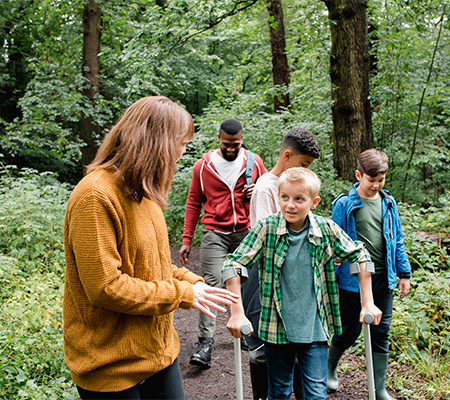
Cerebral palsy symptoms range from mild to severe. Children can lead full lives with therapy and assistive help, like crutches.
Cerebral palsy is a common motor control disorder diagnosed early in childhood. People with cerebral palsy have issues with their mobility, balance or posture. Cerebral palsy isn’t a single condition, but rather a group of disorders that results from an injury or abnormality in the brain. It is static, not progressive.
Common movement disorders of cerebral palsy
- Spastic is the most common kind where muscles are stiff and tight.
- Hypotonic means a child has low muscle tone and their limbs may appear “floppy.”
- Dyskinetic is when there are frequent uncontrolled movements.
- Ataxic affects coordination and balance.
“Cerebral palsy has a spectrum that ranges from mild to severe,” said Dr. Jill Meilahn, Marshfield Children’s physical medicine rehabilitation specialist at Marshfield Clinic Health System. Cerebral palsy can affect different areas of the body. It may present in both legs or impact the arm and leg on the same side. In the most severe cases, both arms and legs are impaired as well as the muscles of the face, mouth and body.
Signs and symptoms
While the specific cause of each case of cerebral palsy may be unknown, the most common cause currently is prematurity. Infection, prenatal stroke or genetic problems can also cause brain damage that leads to cerebral palsy.
Most premature infants are diagnosed while still in the neonatal intensive care unit. Signs include limited or stiff movements in a baby’s arms and legs. As a result they may have scissored or crossed legs that are stiff and hard to move. Infants with cerebral palsy may miss developmental milestones like controlling their head or not rolling over by six months. They may prefer one side of their body or have feeding or swallowing difficulties. If you have concerns, see your pediatrician.
Start treatment early
While there’s no way to fix the brain to cure cerebral palsy, there are ways to live a normal life. An occupational therapist can start working with infants to position, hold and stretch their limbs. Parents can learn these techniques to continue stretching at home. Interventions such as medications, Botox shots and surgeries can decrease muscle tightness or spasticity.
One concern for children using wheelchairs is the long-term risk of osteoporosis. Since they aren’t walking, they aren’t developing strong bones and are at risk for fractures. “We work with these children to do supported standing activities to get weight-bearing exercises,” Meilahn said. “We also recommend calcium and getting out in the sun for vitamin D.”
Treatment plans have changed in recent decades. “Our specialists are a great team to treat the whole situation,” Meilahn said.
These specialists can assess children’s abilities and needs. Bracing or orthopedic surgery addresses deformities. Speech therapy can work with muscle control in the mouth and tongue to improve swallowing and communication.
Children work with physical therapy to build muscle control, balance and coordination. In moderate cases, a child may use assistive mobility devices like crutches, a walker or propel a wheelchair. In severe cases a child may use a motorized wheelchair or require total assistance.
Those who cannot swallow may use a gastrostomy, or G-tube, inserted in the stomach for proper nutrition. These children may also need help communicating. Adaptive communication options are available with iPads and eye-gaze technology.
“Regardless of the severity of cerebral palsy, there are treatments, therapy, assistive equipment and technology that allow children to grow and live full lives,” Meilahn said.
Related Shine365 posts
Siblings of kids with special needs: What you should know
Toddlers toddle by why isn’t mine?
Is your baby sick? Know these non-verbal cues

